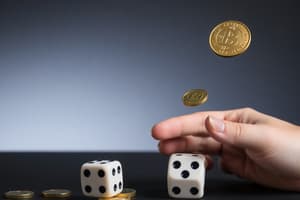Podcast
Questions and Answers
What is the probability of drawing a specific colored ball from a bag containing 5 red balls, 7 blue balls, and 3 green balls?
What is the probability of drawing a specific colored ball from a bag containing 5 red balls, 7 blue balls, and 3 green balls?
- 0.75
- 0.33 (correct)
- 0.5
- 0.2
If you randomly draw one ball from the box that contains 10 balls, what is the probability of drawing a ball with a certain number?
If you randomly draw one ball from the box that contains 10 balls, what is the probability of drawing a ball with a certain number?
- 0.33
- 0.1 (correct)
- 0.2
- 0.05
When rolling a six-sided die, what is the probability of rolling a number other than six which represents a complementary event?
When rolling a six-sided die, what is the probability of rolling a number other than six which represents a complementary event?
- 1/3
- 1/4
- 5/6 (correct)
- 1/6
If you flip a fair coin, what is the probability of getting tails?
If you flip a fair coin, what is the probability of getting tails?
In drawing colored balls from a bag with 5 red balls, 7 blue balls, and 3 green balls, what is the probability of not drawing a blue ball as a complementary event?
In drawing colored balls from a bag with 5 red balls, 7 blue balls, and 3 green balls, what is the probability of not drawing a blue ball as a complementary event?
What is the probability of rolling an even number on a six-sided die?
What is the probability of rolling an even number on a six-sided die?
If you roll two six-sided dice, what is the total number of possible outcomes?
If you roll two six-sided dice, what is the total number of possible outcomes?
In flipping a fair coin twice, what is the probability of getting two consecutive heads?
In flipping a fair coin twice, what is the probability of getting two consecutive heads?
If you have a box with 10 numbered balls, what is the probability of selecting a ball numbered 5?
If you have a box with 10 numbered balls, what is the probability of selecting a ball numbered 5?
When drawing colored balls from a bag, what does it mean if two events are complementary?
When drawing colored balls from a bag, what does it mean if two events are complementary?
Flashcards are hidden until you start studying
Study Notes
Probability: Understanding the Likelihood of Events
Probability is a fundamental concept in mathematics and statistics that deals with quantifying the likelihood of certain outcomes happening. It helps us make informed decisions based on data, assess risks, and predict future events. In this article, we will discuss various forms of probability and how they apply to everyday situations such as rolling a dice, flipping a coin, selecting a numbered ball from a box, drawing colored balls from a bag, and understanding complementary events.
Rolling a Dice
When you roll a single six-sided die, there are six possible outcomes: numbers 1 through 6. Each side of the die has equal probability of showing up when rolled, which means each outcome has a probability of 1 out of 6 or approximately 0.17. If you were to roll two six-sided dice, the total number of possible outcomes would increase to 6 raised to the power of 2 or 36 different combinations.
Flipping a Coin
Another common example of probability involves flipping a coin. Since a fair coin has two equally likely sides - heads (H) and tails (T) - each flip has a 50% chance of either outcome. If you were to flip a coin multiple times, the probability of getting a specific sequence of heads and tails would depend on the number of flips and the number of heads you're looking for.
Selecting a Numbered Ball from a Box
Suppose you have a box with 10 numbered balls, numbered 1 through 10. If you randomly draw one ball from the box, the probability of drawing any specific ball is 1 out of 10, or approximately 0.1. To find the probability of drawing a ball with a certain number, you would divide the number of balls with that number by the total number of balls.
Drawing Colored Balls from a Bag
Similar to the previous example, let's say you have a bag with 5 red balls, 7 blue balls, and 3 green balls. If you were to draw one ball from the bag, the probability of drawing a red ball would be 5 out of 15, or approximately 0.33. To find the probability of drawing a ball of a specific color, you would divide the number of balls of that color by the total number of balls in the bag.
Complementary Events in Probability
In probability, a complementary event is an event that occurs in the opposite way to the original event. For example, if the original event is rolling a six on a six-sided die, the complementary event would be rolling a number other than a six. The probability of a complementary event is equal to 1 minus the probability of the original event.
These examples illustrate how probability can be applied to various situations in our daily lives. By understanding the likelihood of certain outcomes, we can make more informed decisions and predictions. Whether it's flipping a coin, rolling a dice, or drawing colored balls from a bag, probability provides a framework for understanding the world around us.
Studying That Suits You
Use AI to generate personalized quizzes and flashcards to suit your learning preferences.



